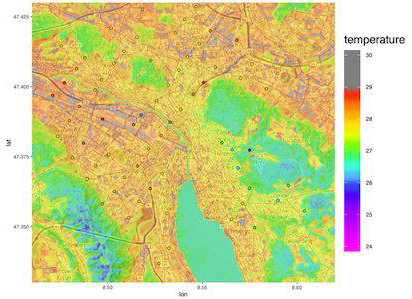
Small scale modelling of meteorological variables
meteoblue calculates small-scale meteorological variable fields for cities with the horizontal resolution of 10m for each measurement time step of 15 minutes. The meteoblue city climate models interpolate locations between sensor locations with special techniques utilising data from satellites, as well as digital surface and elevation models.
Air temperature, precipitation, wind speed and wind direction are assessed for any location in the city, bringing weather information to the inhabitants’ doorsteps. Based on the small-scale air temperature field, urban heat islands are detected, as well as cold inflows.
In addition, flood and hail warnings for the city can be created on the basis of high-resolution precipitation data. Air pollution is assessed automatically by combining local air pollution data sources with a three-dimensional wind field calculation.

High computational power from the cluster
meteoblue runs city climate models on a very fine horizontal resolution down to 0.5 m (see the sky view factor figure on the left). The sky view factor expresses the proportion of sky visible from a point on a surface. Street canyons or areas covered by trees have a low sky view factor in contrast to the high sky view factor of open places and building rooftops.
The model calculations require substantial computational power. Historical data, nowcast, 7-day forecast as well as climate projections are all calculated for any point in the city and available from the meteoblue databases.

High accuracy of city climate models
The meteoblue city climate models achieves unique accuracy with errors below 1°C (hourly MAE) with the spatial interpolation technique, with a decreasing error when using more stations.
We are also able to calculate the number of stations needed to achieve the desired accuracy of modelled data. Based on our existing verification studies, for our 24h forecast an accuracy of 1.2 °C hourly MAE for air temperature can be expected, based on our existing verifications.


